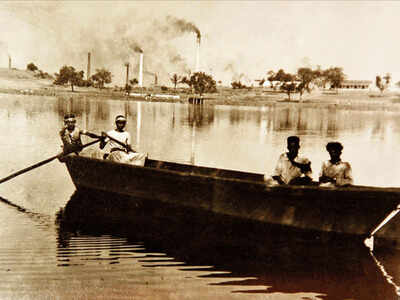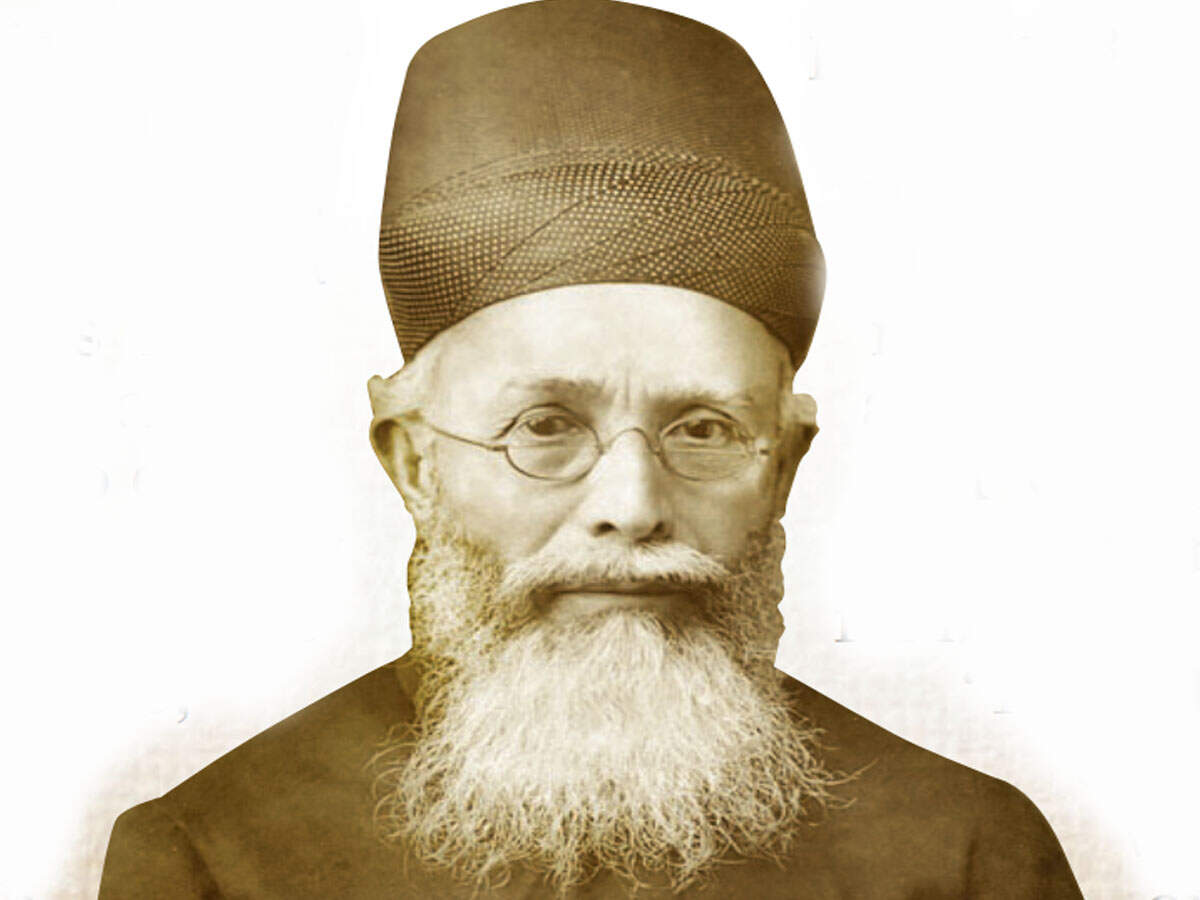
By: Soumitra Trivedi
Dadabhai Naoroji, who propounded the “drain of wealth” theory to describe the loot by the British imperialists, was the force behind the nascent Make in India movement in the 19th century. Without the help of Naoroji, Ranchhodlal Chhotalal’s entrepreneurial dream — to build a textile empire — would not have been fulfilled in 1861. Today marks the 194th birth anniversary Naoroji, hailed as the Grand Old Man of India.
Naoroji, the Gujarati who co-founded India’s first political party — the Congress — was instrumental in establishing Ahmedabad’s first textile mill. Historians have noted that Naoroji bought machinery for Ranchhodlal’s mill project from London, not once but twice! While employed in the British government, Ranchhodlal tried to float a cotton mill and also attempted to order machinery from London. However, his efforts failed.
 Dadabhai Naoroji
Dadabhai Naoroji
After losing his job with the British government following allegations of corruption, Ranchhodlal joined a moneylender’s firm.
With the firm’s help, he again pushed to establish a cotton-ginning mill. But that project was stillborn too, write Achyut Yagnik and Suchitra Sheth in their book “The Shaping of Modern Gujarat: Plurality, Hindutva and Beyond.” They go on to say: “By this time three mills had been established in Bombay and their success increased the confidence of Ahmedabad merchants who now gave their backing to Ranchhodlal. He floated the Ahmedabad Spinning and Weaving Company in 1858.”
According to Yagnik and Sheth, by that time Naoroji had moved to England as a partner in Cama and Company, the first Indian trading firm in England. “Ranchhodlal was acquainted with Naoroji and orders for the machinery for this project were placed through Naoroji,” the authors write.
However, Ranchhodlal was unlucky once more. “The main engineer for the project died and the ship carrying the machinery sank,” the book says. “Orders were placed once again through Naoroji and the ship landed successfully at Cambay. The machinery was transported to Ahmedabad in bullock carts and the first textile mill was established in 1861.”
The story is recalled in a paper by Prof Howard Spodek, who notes that the machinery burned and sank into sea. “Ranchhodlal himself spent about three months in Cambay supervising the unloading of the machinery onto the bullock-carts by which it was transported 52 miles to Ahmedabad,” Spodek has noted. “Once in Ahmedabad, the death and incompetence of various English technicians led Ranchhodlal and an astrologer friend to attempt, unsuccessfully, to erect the mill themselves.”
Dadabhai Naoroji, who propounded the “drain of wealth” theory to describe the loot by the British imperialists, was the force behind the nascent Make in India movement in the 19th century. Without the help of Naoroji, Ranchhodlal Chhotalal’s entrepreneurial dream — to build a textile empire — would not have been fulfilled in 1861. Today marks the 194th birth anniversary Naoroji, hailed as the Grand Old Man of India.
Naoroji, the Gujarati who co-founded India’s first political party — the Congress — was instrumental in establishing Ahmedabad’s first textile mill. Historians have noted that Naoroji bought machinery for Ranchhodlal’s mill project from London, not once but twice! While employed in the British government, Ranchhodlal tried to float a cotton mill and also attempted to order machinery from London. However, his efforts failed.

After losing his job with the British government following allegations of corruption, Ranchhodlal joined a moneylender’s firm.
With the firm’s help, he again pushed to establish a cotton-ginning mill. But that project was stillborn too, write Achyut Yagnik and Suchitra Sheth in their book “The Shaping of Modern Gujarat: Plurality, Hindutva and Beyond.” They go on to say: “By this time three mills had been established in Bombay and their success increased the confidence of Ahmedabad merchants who now gave their backing to Ranchhodlal. He floated the Ahmedabad Spinning and Weaving Company in 1858.”
According to Yagnik and Sheth, by that time Naoroji had moved to England as a partner in Cama and Company, the first Indian trading firm in England. “Ranchhodlal was acquainted with Naoroji and orders for the machinery for this project were placed through Naoroji,” the authors write.
However, Ranchhodlal was unlucky once more. “The main engineer for the project died and the ship carrying the machinery sank,” the book says. “Orders were placed once again through Naoroji and the ship landed successfully at Cambay. The machinery was transported to Ahmedabad in bullock carts and the first textile mill was established in 1861.”
The story is recalled in a paper by Prof Howard Spodek, who notes that the machinery burned and sank into sea. “Ranchhodlal himself spent about three months in Cambay supervising the unloading of the machinery onto the bullock-carts by which it was transported 52 miles to Ahmedabad,” Spodek has noted. “Once in Ahmedabad, the death and incompetence of various English technicians led Ranchhodlal and an astrologer friend to attempt, unsuccessfully, to erect the mill themselves.”
Trending Topics
LATEST VIDEOS
City
 Biker fined Rs 23000 in Gurugram
Biker fined Rs 23000 in Gurugram  Guntur: TDP leaders stop YSRCP Dalit MLA Vundavalli Sridevi from entering Ganesh pandal
Guntur: TDP leaders stop YSRCP Dalit MLA Vundavalli Sridevi from entering Ganesh pandal  Kerala’s first transwoman journalist 22-year-old Heidi Saadiya makes her debut with Chandrayaan-2 reportage
Kerala’s first transwoman journalist 22-year-old Heidi Saadiya makes her debut with Chandrayaan-2 reportage  Delhi abduction solved: Servant killed 91-year-old man, carried his body away in fridge
Delhi abduction solved: Servant killed 91-year-old man, carried his body away in fridge
More from TOI
Navbharat Times
Featured Today in Travel
Quick Links
Lok Sabha Election Schedule 2019Lok Sabha Election NewsDelhi Capitals teamMI team 2019Rajasthan Royals 2019RCB team 2019Maharashtra Lok Sabha ConstituenciesBJP Candidate ListBJP List 2019 TamilnaduShiv Sena List 2019AP BJP List 2019Mamata BanerjeeBJP List 2019 MaharashtraPriyanka GandhiBJP List 2019 KarnatakaAMMK Candidate List 2019BJP List 2019 WBLok Sabha Elections in Tamil NaduBSP List 2019 UPNews in TamilLok Sabha Poll 2019Satta Matka 2018PM ModiMahagathbandhanNagpur BJP Candidate ListChandrababu NaiduTamil Nadu ElectionsUrmila MatondkarNews in TeluguMadras High CourtTejashwi YadavArvind KejriwalTejasvi SuryaPawan KalyanArvind KejriwalYogi AdityanathJaya PradaSatta King 2019Srinagar encounter
Get the app





